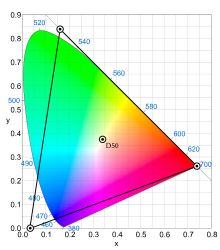| Reference Output Medium Metric RGB | |
 CIE 1931 xy chromaticity diagram showing the chromaticities enclosed by the ProPhoto RGB color space and location of the primaries. The D50 white point is shown in the center. The areas of the triangle that are outside the colored area are imaginary colors. | |
| Abbreviation | ROMM RGB |
|---|---|
| Native name | |
| Status | Published |
| Latest version | 2013 April 2013[1] |
| Organization | |
| Committee | ISO/TC 42 (TC)[1] |
| Authors | Kodak |
| Base standards | RGB |
| Domain | Color space, color model |
| Website | |

The ProPhoto RGB color space, also known as ROMM RGB (Reference Output Medium Metric), is an output referred RGB color space developed by Kodak. It offers an especially large gamut designed for use with photographic output in mind. The ProPhoto RGB color space encompasses over 90% of possible surface colors in the CIE L*a*b* color space, and 100% of likely occurring real-world surface colors documented by Michael Pointer in 1980,[3][4] making ProPhoto even larger than the Wide-gamut RGB color space. The ProPhoto RGB primaries were also chosen in order to minimize hue rotations associated with non-linear tone scale operations. One of the downsides to this color space is that approximately 13% of the representable colors are imaginary colors that do not exist and are not visible colors.
When working in color spaces with such a large gamut, it is recommended to work in 16-bit color depth to avoid posterization effects. This will occur more frequently in 8-bit modes as the gradient steps are much larger.
There are two corresponding scene space color encodings known as RIMM RGB (Reference Input Medium Metric) intended to encode standard dynamic range scene space images, and ERIMM RGB intended to encode extended dynamic-range scene space images.[5][6]
YouTube Encyclopedic
-
1/5Views:243 77615 0681 204374 7502 113
-
Color Spaces Explained! sRGB, Adobe RGB (1998), ProPhoto RGB
-
COLOR SPACE for PHOTOGRAPHY 🌈 WHAT to use, WHY and WHEN ( Keeping it SIMPLE )
-
Episode 551 - 📸 Prophoto RGB, Adobe RGB, sRGB, what color space should you use and how?
-
Does Your Color Change After Export in Photoshop?
-
Color Management Part 3... sRGB? Adobe RGB? ProPhotoRGB
Transcription
Development
The development of ProPhoto RGB and other color spaces is documented in an article[7] summarizing a presentation by one of its developers Geoff Wolfe at Kodak, now senior research manager at Canon Information Systems Research Australia, at the IS&T/SPIE Color Imaging Conference in 2011.
Encoding primaries
| Color | CIE x | CIE y | CIE X | CIE Y | CIE Z |
|---|---|---|---|---|---|
| red | 0.734699 | 0.265301 | 0.79767 | 0.28804 | 0.00000 |
| green | 0.159597 | 0.840403 | 0.13519 | 0.71188 | 0.00000 |
| blue | 0.036598 | 0.000105 | 0.03134 | 0.00009 | 0.82491 |
| white | 0.345704 | 0.358540 | 0.96420 | 1.00000 | 0.82489 |
Viewing environment
- Luminance level is in the range of 160–640 cd/m2.
- Viewing surround is average.
- There is 0.5–1.0% viewing flare.
- The adaptive white point is specified by the chromaticity values for CIE Standard illuminant D50 (, ).
- The image color values are assumed to be encoded using flareless (or flare corrected) colorimetric measurements based on the CIE 1931 Standard Colorimetric Observer.
Encoding function
where
and
- is the maximum integer value used in the encoding function (e.g. 255 for 8-bit configuration)
and
References
- ^ a b c ISO (April 2013). "ISO - ISO 22028-2:2013 - Photography and graphic technology — Extended colour encodings for digital image storage, manipulation and interchange — Part 2: Reference output medium metric RGB colour image encoding (ROMM RGB)". ISO. 2013. Retrieved 2021-04-19.
- ^ International Imaging Industry Association (2002). "ANSI/I3A IT10.7666-2002 - Photography - Electronic Still Picture Imaging - Reference Output Medium Metric RGB Color Encoding (ROMM-RGB)". ANSI Webstore. Retrieved 2021-04-19.
- ^ Pointer, M. R. (1980). "The Gamut of Real Surface Colours. Color Res. Appl., 5". Color Research & Application (published 2007-03-15). 5 (3): 145–155. doi:10.1002/col.5080050308. Retrieved 2021-04-19.
- ^ Jansen, Kid (2014-02-19). "The Pointer's Gamut - The coverage of real surface colors by RGB color spaces and wide gamut". TFT Central. Retrieved 2017-10-29.
- ^ ISO (August 2012). "ISO - ISO/TS 22028-3:2012 - Photography and graphic technology — Extended colour encodings for digital image storage, manipulation and interchange — Part 3: Reference input medium metric RGB colour image encoding (RIMM RGB)". ISO. 2012. Retrieved 2021-04-19.
- ^ International Imaging Industry Association (2002). "ANSI/I3A IT10.7466-2002 - Photography - Electronic still picture imaging - Reference Input Medium Metric RGB Color encoding (RIMM-RGB)". ANSI Webstore. Retrieved 2021-04-19.
- ^ Naty (2011-12-21). "Real-Time Rendering · 2011 Color and Imaging Conference, Part VI: Special Session". www.realtimerendering.com. Retrieved 2017-10-29.
External links
- Specification of ROMM RGB
- Information page about ROMM RGB including a downloadable ICC format profile.
- Understanding ProPhoto RGB
- Color Spaces: Beyond Adobe RGB
- Why Use the ProPhoto RGB Color Space?






